ACUFO-1943-00-00-FRANCEORGERMANY-1
The image below circulated from the 2000s on the Web, on Youtube, then on various social networks, without explanation except that it would be a photo of “Foo-Fighters” taken during the Second World War:
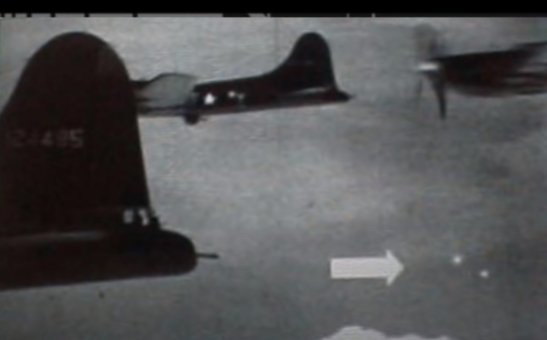
|
In this file, I show that one of the B-17s appearing in the image was very well known, that the origin of the image remains unknown, and that what was said to be “Foo-Fighters” were probably not.
| Date: | Between April 16, 1943, and May 17, 1943 |
|---|---|
| Time: | Day. |
| Duration: | ? |
| First known report date: | 2000's |
| Reporting delay: | 6 decades. |
| Country: | France or Germany |
|---|---|
| State/Department: | |
| City or place: |
| Number of alleged witnesses: | ? |
|---|---|
| Number of known witnesses: | 0 |
| Number of named witnesses: | 0 |
| Reporting channel: | Picture on the Web. |
|---|---|
| Visibility conditions: | Night. |
| UFO observed: | ? |
| UFO arrival observed: | ? |
| UFO departure observed: | ? |
| UFO action: | ? |
| Witnesses action: | ? |
| Photographs: | Yes. |
| Sketch(s) by witness(es): | No. |
| Sketch(es) approved by witness(es): | No. |
| Witness(es) feelings: | ? |
| Witnesses interpretation: | ? |
| Sensors: |
[ ] Visual:
[ ] Airborne radar: [ ] Directional ground radar: [ ] Height finder ground radar: [X] Photo: 1. [ ] Film/video: [ ] EM Effects: [ ] Failures: [ ] Damages: |
|---|---|
| Hynek: | DD |
| Armed / unarmed: | Armed, 11 7.62 mm machine guns. |
| Reliability 1-3: | 1 |
| Strangeness 1-3: | 1 |
| ACUFO: | Possible parachutes. |
[Ref. www1:] ON THE WEB:
This image has been circulated from the year 2000 on the Web, on Youtube, on social media, without any explanations except that is an image of Foo-Fighters taken during WWII:

|
In 2024, there are only few copies of this image still appearing on the Web.
[Ref. gfn1:] WEBSITE "GREY FALCON":

|
This photograph appears with the caption:
Interestingly enough, with all the sightings and reports, and all the gun cameras and high altitude photographs, no truly GOOD pictures of Foo Fighters from the period have surfaced.
[...]
This photo shows B17's in combat formation, some UFO's off in the distance and a fighter closing on a flying fortress.
Is this fighter, a single engined allied plane or an enemy Me109 - by it's cowling it looks like an Axis fighter.
This photo looks like a fake - notice how close the fighter is to the B17 and how out of proportion the fighter is.
Then again this photo could be legit, but where is the tracer fire?
Maybe it's a doctored photo from film stock from the 1962 movie “The War Lover”.
[Ref. jsn1:] JEAN-CLAUDE SIDOUN:
This author publishes the same image with this caption:
"Photograph of Foo-Fighters flying very close to an American bombing squadron. These luminous balls are very fast. They greatly exceed the performance of the aircraft used by the Allies over Nazi Germany."
The US B-17 “Flying Fortress” was a heavy bomber fitted with five 7.62 machine guns for its defense against enemy fighter planes.
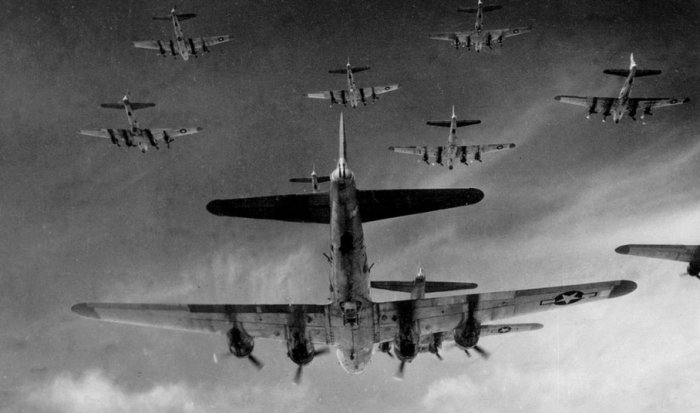
|
In the photo, the serial number of the aircraft is readable: 41-24485.
This serial number shows that this B-17 was no less than the “star” of the B-17s, the “Memphis Belle.”
The “Memphis Belle” was a B-17 version F-10-BO of the 324th Bomb Squadron (Heavy), 91st Bomb Group (Heavy), 1st Combat Wing, 1st Air Division, 8th Bomber Command, based at Bassingbourn in England.
The “Memphis Belle” was the third plane and crew to successfully complete 25 missions during the Second World War, which according to custom, then returned to the USA. The aircraft is now in the National Museum of the United States Air Force at Wright-Patterson Air Force Base, Ohio.
The 25 missions were:
| 1 | November 7, 1942 | Brest, France | Brest submarine base |
| 2 | November 9, 1942 | Saint-Nazaire, France | Saint-Nazaire submarine base |
| 3 | November 17, 1942 | Saint-Nazaire, France | Saint-Nazaire submarine base |
| 4 | December 6, 1942 | Lille, France | Locomotive plant |
| 5 | December 20, 1942 | Romilly-sur-Seine, France | German airfield |
| 6 | January 3, 1943 | Saint-Nazaire, France | Saint-Nazaire submarine base |
| 7 | January 13, 1943 | Lille, France | Locomotive plant |
| 8 | January 23, 1943 | Lorient, France | Lorient submarine base |
| 9 | February 1943 | Emden, Germany | Ford military vehicle plant |
| 10 | February 14,1943 | Hamm, Germany | Railway station |
| 11 | February 16, 1943 | Saint-Nazaire, France | Saint-Nazaire submarine base |
| 12 | February 26, 1943 | Wilhelmshaven, Germany | Navy base |
| 13 | February 27, 1943 | Brest, France | Brest submarine base |
| 14 | March 6, 1943 | Lorient, France | Lorient submarine base |
| 15 | March 12, 1943 | Rouen, France | Railway station |
| 16 | March 13, 1943 | Abbeville, France | Airfield |
| 17 | March 22, 1943 | Wilhelmshaven, Germany | Navy base |
| 18 | March 28, 1943 | Rouen, France | Railway station |
| 19 | April 5, 1943 | Anvers, Belgium | Aircraft engine plant |
| 20 | April 16, 1943 | Lorient, France | Lorient submarine base |
| 21 | April 17, 1943 | Brême, Germany | Focke-Wulf aircraft plant |
| 22 | May 1, 1943 | Saint-Nazaire, France | Saint-Nazaire submarine base |
| 23 | May 4, 1943 | Anvers, Belgium | Ford truck plant |
| 24 | May 15, 1943 | Wilhelmshaven, Germany | Naval plant |
| 25 | May 17, 1943 | Lorient, France | Lorient submarine base |
The 26th mission was a victory tour in the United States.
The “Memphis Belle” was the “star” of the B-17s because it had been the subject of numerous news reports on its missions and its crew, as well as a film by director William Wyler. William Wyler was born Willi Wyler on July 1, 1902 in Mulhouse, my hometown, then part of Germany. In 1922, he migrated to the USA where he became a renowned director of numerous films; everyone has heard about his epic “Ben-Hur”, rewarded with eleven Oscars.
In 1942, he enlisted in the United States Army Air Forces with the rank of Major, and made three propaganda documentaries on the ongoing war, including “Memphis Belle: A Story of a Flying Fortress”, filmed in England and in German skies in May 1943 and released in theaters in 1944. The “Memphis Belle” was already known through several other reports shown in cinemas in the USA.
I was able to see images from this film projected on the Place de la Réunion in Mulhouse in July 2022 as part of my city's retrospective dedicated to William Wyler in 2022, “The William Wyler Year”.
I was able to watch several times the 45-minute film, broadcast in 1944 in American cinemas, by William Wyler about the “Memphis Belle” - it is published under the title “Memphis Belle: The Archives in Color”, on DVD, by Actium. The film was shot during the last missions of the “Memphis Belle”, on April 16, 1943, on Lorient in France, May 1, 1943 on Saint-Nazaire in France, May 15, 1943 on Wilhelmshaven in Germany, and May 17, 1943 in Lorient in France. William Wyler was on board.
Images from February 26, 1943 were taken from another B-17, the “Jersey Bounce.”
A member of his film crew filming from another B-17, First Lieutenant Harold J. Tannenbaum, a World War I veteran, was killed during filming on April 16, 1943; Wyler himself lost hearing in his right ear and became partially deaf in the other ear due to flak noise.
To do the film, Wyler mounted 16mm cameras in the nose, tail, fuselage, and radio operator's seat of the “Memphis Belle”. The film was in color, without sound, the sound track being be added later.
Wyler was promoted to Lieutenant Colonel in late 1944, and would fly to Italy for his next documentary, “Thunderbolt!” His 1944 documentary “The Fighting Lady”, about the American aircraft carrier USS Yorktown, won the Academy Award for Best Documentary Film in 1945.
The crew of the “Memphis Belle”, aged 19 to 26, had had three successive top turret gunners, Leviticus “Levi” Dillon, Eugene Adkins, and Harold Loch. There had been three side gunners, Harold Loch, who later moved to the top turret, Bill Winchell, Cecil Scott, E. Scott Miller. The rear turret was occupied by John Quinlan. Radio operator was Robert Hanson, bombardier was Vince Evans, pilot was Captain Robert “Bob” Morgan, co-pilot was James Verinis for the first 5 missions, the navigator was Charles Leighton.
The film has been the subject of several re-releases. Besides the DVD versions, there were a “Blue Ray” versions; and in 2016, documentary director Eric Nelson was able to retrieve the original 34 reels from the National Archives and Records Administration; he had the images restored, removing the scratches, and made a full-length documentary from the 90 hours of film entitled “The Cold Blue.”
My idea about the alleged “Foo-fighter” photo discussed here was of course, since I had identified the plane, to check whether the image existed either as a photo or in one or the other documentary or report. The photo is recognizable since we see two B-17s and a fighter plane. I've seen several versions of Wyler's documentary, and some other excerpts republished in a B-17 documentary, but I couldn't find this image. This obviously does not prove that it did not exist.
There is of course the possibility that the image exists somewhere in Wyler's 90 hours raw footage; there is also the possibility that the so-called “Foo-fighter” was “cleaned up”, not for cover-up but interpreted as a defect, which might only have appeared in one frame of the film, for example.
But on the other hand, there is not the slightest trace that the “Memphis Belle” encountered any “Foo-fighter”. No contemporary or later testimony by any member of its crew, nor have I found anything about a possible “foo-fighter” reported during its missions (the photo suggests that the “thing” would have been “seen” since another B-17 accompanying the “Memphis Belle”.
If we assume that the image is authentic, the matter is nonetheless explicable prosaically. Just watch the film. There are numerous sequences in which the “Memphis Belle” and the other unit B-17s are attacked by German fighter planes, Focke-Wulfe Fw-190s, Messerschmitt Me-109s. By simple “freeze frame”, we can create images that some would call “Foo-fighters” as in the examples below:
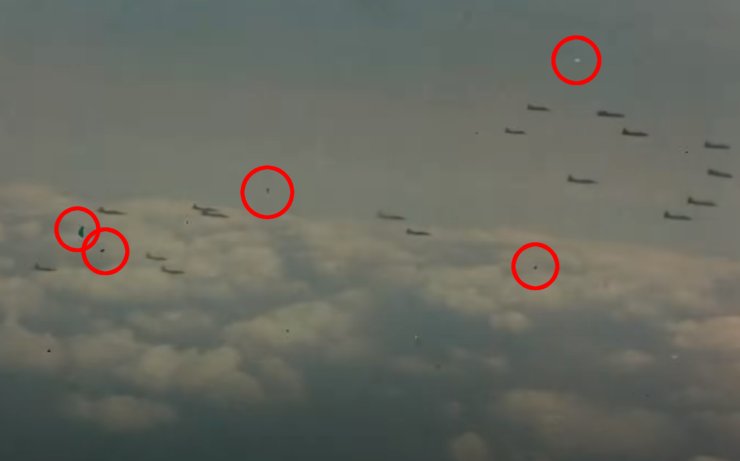
|
We can also obtain “Foo-fighters” from fire from the Memphis Belle's machine guns, and all kinds of miscellaneous “artifacts” (dust, scratches, white spots, black spots, etc.), like shown below:
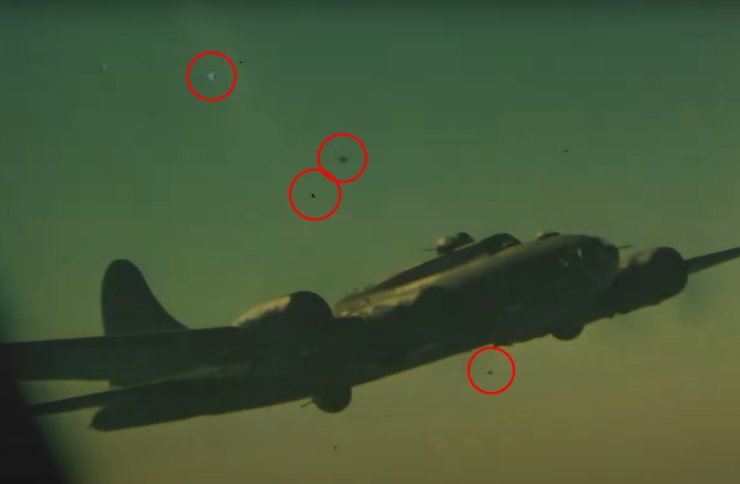
|
On this image, these are parachutes, from a downed B-17 crew bailing out:
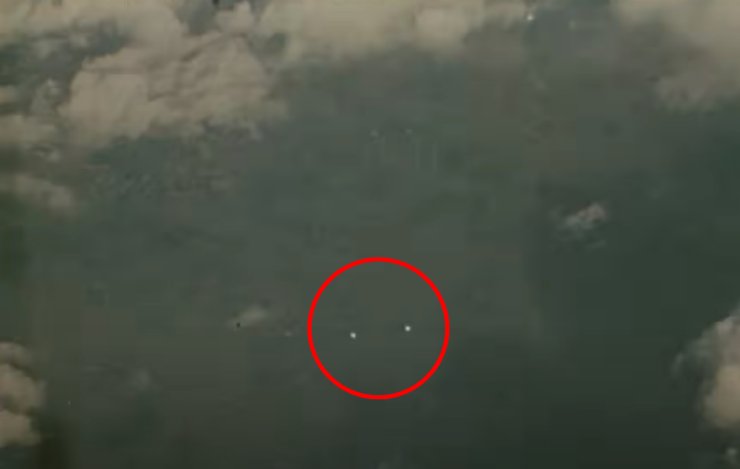
|
In this image, a German Me-109 explodes:
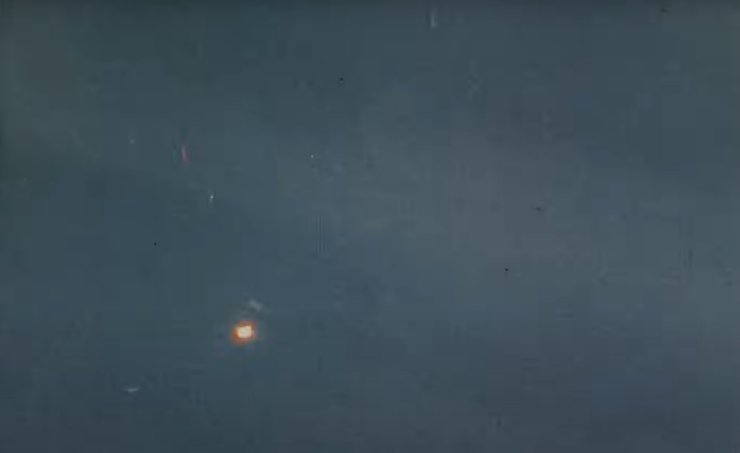
|
In this image, reflections on the blister of a machine gunner:
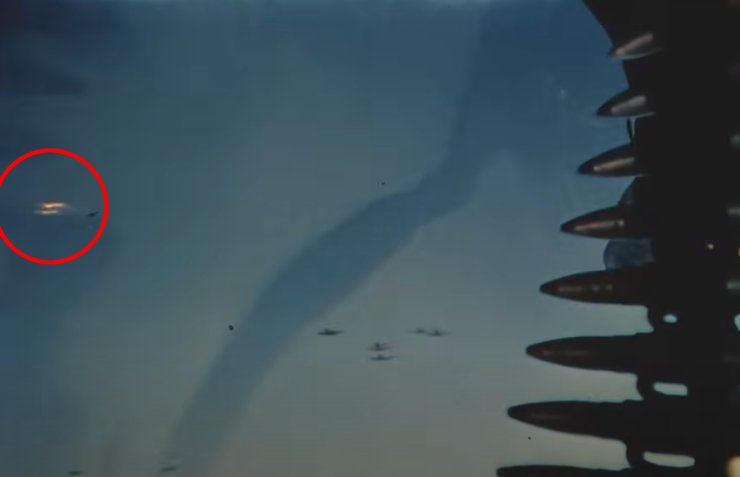
|
Note that the argument in [gfn1] according to which the “photo” is false because “the fighter is close” to the B-17 does not hold; in the documentary's combat sequences, German fighter planes literally and frequently come close to the B-17s.
Note that the idea in [gfn1] that the image could come from the fiction film “The War Lover” (1962) does not hold, it results from the fact that “Grey Falcon” did not see that the serial number of the B-17 indicates that the B-17 on the image was the “Memphis Belle”, which does not appear in this fictional film.
It is not possible to exclude that the image was forged.
But if we want to stick to an “ordinary” honest explanation, my opinion is that what would best explain it compared to what can be seen in B-17 operations footage, would be that these were two parachutes from a crew of a downed B-17.
Possible parachutes.
* = Source is available to me.
? = Source I am told about but could not get so far. Help needed.
| Main author: | Patrick Gross |
|---|---|
| Contributors: | None |
| Reviewers: | None |
| Editor: | Patrick Gross |
| Version: | Create/changed by: | Date: | Description: |
|---|---|---|---|
| 0.1 | Patrick Gross | January 23, 2024 | Creation, [www1], [gfn1]. |
| 1.0 | Patrick Gross | January 23, 2024 | First published. |
| 1.1 | Patrick Gross | June 2, 2024 | Addition [jsn1]. |